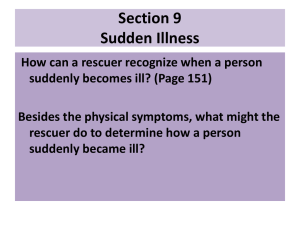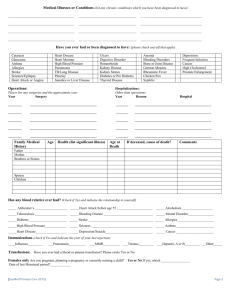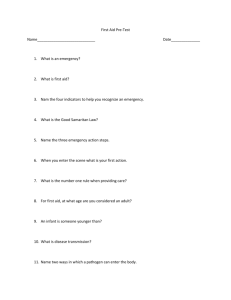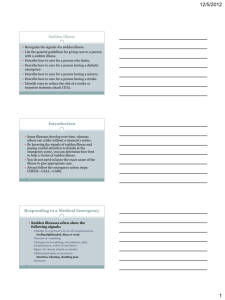Section 5
advertisement
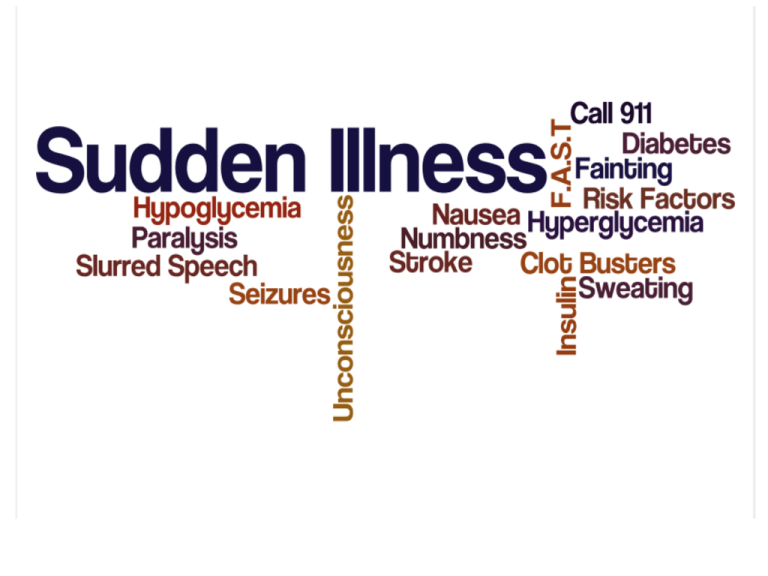
Section 5 Sudden Illness How can a rescuer recognize when a person suddenly becomes ill? (Page 71) When does the rescuer call 911 What would the rescuer do until help arrives Don’t second guess ---call 911 Fainting The definition of fainting is: The insufficient supply of blood to the brain for a short period of time •http://www.youtube.com/watch?v=kxNB9HLfMM&feature=fvst What to look for that may indicate a person is going to faint • • • • • Weakness Dizziness Pale Cold Clammy skin Sometimes, slurred speech at the onset When does the rescuer call 911 Call 911 when in doubt about the condition of the person who has fainted. Call 911 if the person does not fully recover How does the rescuer treat a victim that has fainted? • Place the victim on their back • Elevate their feet 8-12 inches if no head, neck or back injuries are suspected • Loosen restrictive clothing • Monitor the A. B. C’s • Call 911 What is a Seizure? Seizures occur when the normal workings of the brain are disrupted by injury, disease, infection or electricity. A common disorder that causes seizures is Epilepsy. A Febrile Seizures Occurs in infants and young children as a result of a high fever due to infections in the body What the victim might experience before a seizure • An aura sensation (as of a cold breeze or bright light) that precedes the onset of certain disorders such as a migraine attack or epileptic seizure • • • • Hallucinations Strange tastes Strange sounds An urgency to get to safety What the rescuer might see in a seizure victim (Page 73) • Blank stares • Unresponsiveness • Uncontrolled muscle contractions called ”convulsions” • Sudden rise in body temperature • Upward rolling of the eyes First Aid for Seizures http://app.discoveryeducation.com/player/? assetGuid=64eb4cb7-17ae-4ad7-a8a11c27013c2923&fromMyDe=0&isPrinterFrie ndly=0&provider=&isLessonFromHealth=0 &productcode=US&isAssigned=false&inclu deHeader=YES&homeworkGuid= What the rescuer does until help arrives Do’s Protect the victim from being injured by moving things away Protect the victim’s head Roll them on their side when seizure is over May have to give meds Treatment for Seizure Victims Do not: Try to stop the seizure Hold the person down Put anything between their teeth Allow the seizure to end on its own When to call 911 - The seizure lasts longer than 5 minutes The victim has multiple seizures The victim is pregnant or diabetic The seizures follow high rise in body temp The victim fails to regain consciousness https://www.youtube.com/watch? v=MRZY2a2jnuw A grand mal seizure victim United Streaming The Human Condition: Brain Attack http://app.discoveryeducation.com/play er/view/assetGuid/D3CF5FEA-849247F7-95F9-E742A228702A Stroke A stroke is called a “brain attack” and is the third leading cause of death in the U.S. it, happens when blood flow to the brain is cut off, or when bleeding occurs in the brain. Massive strokes Results of a massive stroke Mini-Strokes A victim is having signals of a stroke, they go away in minutes, but they return over and over again. Risks Factors of having a Stroke High Blood pressure Cigarette Smoking Obesity Diet What causes a young person to have a Stroke? “Fast” Recognition of a Stroke •F ace •A rm •S peech •T ime Care for a Stroke Victim • • • • Call 911 Immediately Have them stop what they are doing Monitor A.B.C’s Make notes of time and symptoms as the stroke progresses Did you Know? • There are drugs used to treat an ongoing stroke. • “Clot-Busters” Diabetes: What is it? The inability of the body to convert sugar from food into energy via insulin produced in the pancreas Type I- called juvenile diabetes and is also called insulin dependent diabetes Type II Diabetes is called adultonset diabetes It is the most common The body makes insulin but not enough to meet the need or the body becomes resistant to the insulin produced It can be maintained with pills and/or insulin Signs and Signals of Diabetic Emergencies • • • • • Pale, Cold, Clammy skin Dizziness and a shakiness Confusion Numbness Change in level of consciousness Hyperglycemia A diabetic reaction in which there is too much sugar in the blood Treatment depends on the victim’s symptoms and if they are a known diabetic or not. Hypoglycemia A diabetic reaction in which there is too little sugar in the blood. Treatment would be to give a sugar source if fully conscious. When to call 911 The person becomes unconscious The person is conscious but unable to swallow The person does not feel better within 5 minutes after taking a sugar source Allergic Reactions Caused by an overreaction of the immune system to a foreign substance Infection Medications Exercise Temperature Emotions What to look for Hives Itching Rash Weakness Nausea and Vomiting Stomach cramps Dizziness Trouble breathing (Wheezing) When to call 911 Has Trouble breathing Complains of throat tightening Tells you that they are allergic to a specific substance Is unconscious Poisoning About 92% of all poisonings take place in the home What is a poison? Any substance that causes injury, illness or death if it enters the body. The Four Types of Poisoning Swallowed- poisons that can be swallowed include foods, meds, chemicals and certain plants Inhaled Poisons Absorbed Injected What to look for (Page 80-81) How will you know if someone who is ill has been poisoned? Try to get information from the person or bystanders Check the scene for unusual odors, flames, smoke, opened containers, open medical cabinets Check the bullets on page 80-81 When would you call 911? Unconsciousness Breathing difficulties Call 911 or the National Poison Control Center 1-800-222-1222 What to do until help arrives Remove the person from the poisonous source Check level of consciousness and life-threatening conditions Ask questions and look for clues Do not give the victim anything to eat or drink unless directed by the Poison Control Center or EMS Focus on Prevention List ways that you think poisoning can be prevented Let’s read pages 81 and 82 to best understand how to prevent poisoning especially in children Special Care Considerations for poisoning. (page 83) Toxic Fumes Chemicals Substance Abuse What to look for Behavioral changes that are unexplained Sudden mood changes Restlessness, talkativeness, irritability Changes in consciousness Slurred speech or poor coordination Moist flushed skin Chills, nausea and or vomiting Dizziness or confusion Irregular pulse Difficulty or abnormal breathing When to call 911 Is unconscious, confused or seems to be losing consciousness Difficulty breathing Has chest pain or pressure Abdominal pain Is vomiting blood Has seizure, headache or slurred speech Acts violently Objectives for Section 5 • Explain the signals of sudden illness • List situations in which you, the rescuer would not hesitate to call 911. • Explain the condition of fainting, what causes fainting and how is it treated. Objectives continued • Explain why diabetes is the silent killer. List the signs and symptoms and treatment of diabetes. • Explain what a rescuer might see if someone was having a seizure. What is the treatment for a person having a seizure. Objectives continued • What would a rescuer be seeing if a victim is having a stroke. • How would a rescuer treat a stroke victim? • List the risk factors of a stroke. http://app.discoveryeducation.com/player/? assetGuid=be53acb7-f1f0-414f-8b2b71557c838b8e&fromMyDe=0&isPrinterFrie ndly=0&provider=&isLessonFromHealth=0 &productcode=US&isAssigned=false&inclu deHeader=YES&homeworkGuid= 10 most poisonous spiders in the world http://www.environmentalgraffiti.com/news10-most-poisonous-spiders?image=0 Scorpion http://www.youtube.com/watch?v=DE60ig0 CIZc&feature=rellist&playnext=1&list=PL7 YPN8JHENIJOPLZTQKWQZAYH3FQ_FMX Camel spider Sudden Illness Video http://www.youtube.com/watch?v=ApJLBd 8oCOk
